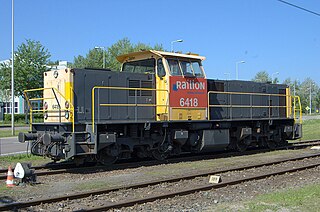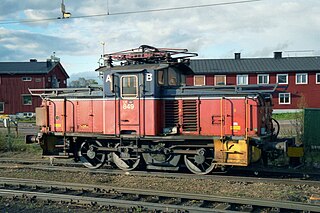
Transport in Sweden is available for all four main modes of transport—air, bus, ferry and rail—assisting residents and visitors without their own vehicle to travel around much of Sweden's 450,295 square kilometres (173,860 sq mi).

The Norwegian railway system comprises 4,109 km of 1,435 mm track of which 2,644 km is electrified and 274 km double track. There are 697 tunnels and 2,760 bridges.

Vygruppen, branded as Vy, formerly the Norwegian State Railways, is a government-owned railway company which operates most passenger train services and many bus services in Norway. The company is owned by the Norwegian Ministry of Transport. Its sub-brands include Vy Buss coach services, CargoNet freight trains and the Swedish train transport company Tågkompaniet. In 2009, NSB carried 52 million train passengers and 104 million bus passengers. On 24 April 2019, passenger train and bus services were rebranded as Vy.

DB Cargo UK, is a British rail freight company headquartered in Doncaster, England.

The Class 66 is a type of six-axle diesel-electric freight locomotive developed in part from the Class 59, for use on the railways of the UK. Since its introduction the class has been successful and has been sold to British and other European railway companies. In Continental Europe it is marketed as the EMD Class 66 (JT42CWR).

The NS Class 6400 is a type of 4 axle diesel-electric freight locomotive. 120 were built by MaK and ABB between 1988 and 1994 for Nederlandse Spoorwegen.

The Ofoten Line is a 43-kilometre (27 mi) railway line in Narvik, Norway. It runs from the Port of Narvik to Riksgränsen on the Norway–Sweden border, where the line continues as the Ore Line via Kiruna and Gällivare to Luleå. The Ofoten Line is single track, electrified at 15 kV 16.7 Hz AC and has seven stations. The line only connects to the rest of the Norwegian railway network via Sweden. The main traffic is up to 12 daily freight trains operated by Malmtrafik that haul iron ore from Sweden to Narvik. In addition, CargoNet operates container trains, branded as the Arctic Rail Express (ARE), and Vy Tåg operates passenger trains, including a night train to Stockholm.

The Meråker Line is a 72-kilometer (45 mi) railway line which runs through the district and valley of Stjørdalen in Trøndelag county, Norway. The line branches off from the Nordland Line at Hell Station and runs eastwards to the Norway–Sweden border, with Storlien Station acting as the border station. From there, the line continues as the Central Line. Traditionally, the Meråker Line was regarded as the whole line from Trondheim Central Station to the border, a distance of 102 kilometers (63 mi). There are two daily passenger train services operated by SJ Norge and a limited number of freight trains hauling lumber and wood chippings.

The NSB Di 8 is a class of diesel-electric locomotives built by Maschinenbau Kiel (MaK), while it was part of Siemens Schienenfahrzeugtechnik, for the Norwegian State Railways (NSB). The locomotives are equipped with a Caterpillar 3516 DI-TA prime mover, which provides a power output of 1,570 kilowatts (2,110 hp) and a starting tractive effort of 270 kilonewtons (61,000 lbf).

The Iron Ore Line is a 398-kilometre (247 mi) long railway line between Riksgränsen and Boden in Norrbotten County, Sweden, owned by Trafikverket. The line also contains two branches, from Kiruna to Svappavaara and from Gällivare to Koskullskulle. The term is often colloquially used to also include the Ofoten Line, from Riksgränsen to Narvik in Norway, and the northernmost part of the Main Line Through Upper Norrland from Boden to Luleå. The railway from Narvik to Luleå is 473 kilometres (294 mi) long.
Jernbaneverket was a government agency responsible for owning, maintaining, operating and developing the Norwegian railway network, including the track, stations, classification yards, traffic management and timetables. Safety oversight was the duty of the Norwegian Railway Inspectorate, while numerous operating companies run trains on the lines; the largest being the state owned passenger company Vy and the freight company CargoNet.

LKAB Malmtrafik, earlier Malmtrafik i Kiruna AB (MTAB), is a Swedish railway company which operates the iron ore freight trains on the Iron Ore Line and the Ofoten Line. MTAB is a wholly owned subsidiary of the mining company Luossavaara–Kiirunavaara (LKAB). In Norway, operations are handled by the subsidiary Malmtrafikk AS (MTAS). Malmtrafik hauls ore from LKAB's mines in Kiruna, Malmberget and Svappavaara to the ports of Luleå and Narvik, the latter located in Norway. The company owns 28 Iore locomotives and 750 hopper cars. Each train is 68 cars long and weighs 8,600 tonnes, allowing the company to transport 33 million tonnes per year.

GB Railfreight (GBRf) is a rail freight company in the United Kingdom. As of 2022, it is owned by the global investment company Infracapital, itself a subsidiary of M&G plc, a UK investment group.

Hector Rail is a Swedish-based independent train haulage provider. It operates in the European rail transport market and possesses its own rolling stock, including a fleet of 100 locomotives. The company provides both locomotives and drivers to freight customers who need to have whole unit trains hauled between two places with a regular timetable.

U is a class of 152 electric shunter locomotives operated by the Swedish State Railways and Trafikaktiebolaget Grängesberg–Oxelösunds Järnvägar (TGOJ) of Sweden, and the Norwegian State Railways (NSB), LKAB and Norsk Jernverk of Norway. They were built by ASEA, Nyqvist och Holm, Motala, ASJ Falun and Thune between 1926 and 1956. NSB gave the class the designation El 10.

Railfreight was a sector of British Rail responsible for all freight operations on the British network. The division was created in 1982 when BR sought to assign particular stock and management to the evolving requirements of freight traffic.

The history of British Rail's corporate liveries is quite complex. Although from the mid-1960s to the 1980s the organisation was associated with "Rail Blue", a number of other schemes were also used, especially when it was split into operating units or "sectors" in the mid-1980s.

Husa Transportation Group is a group of railfreight, logistics and rail services companies founded in 1998, the group's main business arm on foundation was ACTS Nederland BV (ACTS), founded 1989, an open access freight operator in the Netherlands.
SBB Cargo International is a rail transport business founded in 2010 as a joint venture between SBB Cargo and Hupac. It was created to engage in the carriage of international rail freight across the European market.

Lineas is the largest private rail freight operator in Europe. Headquartered in Belgium, it also operates from various sites across France, Germany, Italy, the Netherlands, and Spain. The Federal Holding and Investment Company holds 10% of the shares. Private equity group Argos Wityu and the management of Lineas together hold the remaining 90%.

























